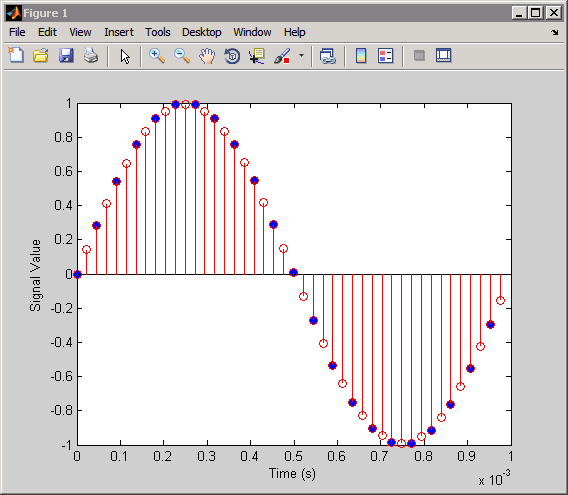mfilt.linearinterp
(Removed) Linear interpolator
mfilt.linearinterp has been removed. Use dsp.FIRInterpolator(L,'Linear')
instead. For more details, see Version History.
Syntax
hm = mfilt.linearinterp(l)
Description
hm = mfilt.linearinterp(l) returns an
FIR linear interpolator hm with an integer interpolation factor
l. Provide l as a positive integer.
The default value for the interpolation factor is 2 when you do not include the
input argument l.
When you use this linear interpolator, the samples added to the input signal have
values between the values of adjacent samples in the original signal. Thus you see
something like a smooth profile where the interpolated samples continue a line
between the previous and next original samples. The example demonstrates this
smooth profile clearly. Compare this to the interpolation process for
mfilt.holdinterp, which creates a stairstep
profile.
Make this filter a fixed-point or single-precision filter by changing the value of
the Arithmetic property for the filter hm as
follows:
To change to single-precision filtering, enter
set(hm,'arithmetic','single');
To change to fixed-point filtering, enter
set(hm,'arithmetic','fixed');
Input Arguments
The following table describes the input argument for
mfilt.linearinterp.
Input Argument | Description |
|---|---|
| Interpolation factor for the filter.
|
Object Properties
This section describes the properties for both floating-point filters (double-precision and single-precision) and fixed-point filters.
Floating-Point Filter Properties
Every multirate filter object has properties that govern the way it behaves
when you use it. Note that many of the properties are also input arguments
for creating mfilt.linearinterp objects. The next table
describes each property for an mfilt.linearinterp filter
object.
Name | Values | Description |
|---|---|---|
|
| Specifies the arithmetic the filter uses to process data while filtering. |
| Character vector | Reports the type of filter object. You cannot
set this property — it is always read only
and results from your choice of
|
| Integer | Interpolation factor for the filter.
|
| ' | Determine whether the filter states get restored to zero for each filtering operation |
| Double or single array | Filter states. |
Fixed-Point Filter Properties
This table shows the properties associated with the fixed-point
implementation of the mfilt.holdinterp filter.
Note
The table lists all of the properties that a fixed-point filter can have. Many of the properties listed are dynamic, meaning they exist only in response to the settings of other properties. To view all of the characteristics for a filter at any time, use
info(hm)
where hm is a filter.
For further information about the properties of this filter or any
mfilt object, refer to Multirate Filter Properties.
Name | Values | Description |
|---|---|---|
| Any positive or negative integer number of bits. Depends on L. [29 when L=2] | Specifies the fraction length used to interpret data output by the accumulator. |
| Any integer number of bits [33] | Sets the word length used to store data in the accumulator. |
| fixed for fixed-point filters | Setting this to |
| [true], false | Specifies whether the filter automatically
chooses the proper fraction length to represent
filter coefficients without overflowing. Turning
this off by setting the value to
|
| Any integer number of bits [16] | Specifies the word length to apply to filter coefficients. |
| [FullPrecision], SpecifyPrecision | Controls whether the filter automatically
sets the output word and fraction lengths, product
word and fraction lengths, and the accumulator
word and fraction lengths to maintain the best
precision results during filtering. The default
value, |
| Any positive or negative integer number of bits [15] | Specifies the fraction length the filter uses to interpret input data. |
| Any integer number of bits [16] | Specifies the word length applied to interpret input data. |
| Any positive or negative integer number of
bits [ | Sets the fraction length used to interpret the numerator coefficients. |
| Any positive or negative integer number of bits [29] | Determines how the filter interprets the
filter output data. You can change the value of
|
| Any integer number of bits [33] | Determines the word length used for the
output data. You make this property editable by
setting |
| saturate, [wrap] | Sets the mode used to respond to overflow
conditions in fixed-point arithmetic. Choose from
either |
| [ | Sets the mode the filter uses to quantize numeric values when the values lie between representable values for the data format (word and fraction lengths).
The choice you make affects only the accumulator and output arithmetic. Coefficient and input arithmetic always round. Finally, products never overflow — they maintain full precision. |
| [true], false | Specifies whether the filter uses signed or unsigned fixed-point coefficients. Only coefficients reflect this property setting. |
|
| Contains the filter states before, during,
and after filter operations. States act as filter
memory between filtering runs or sessions. The
states use |
Filter Structure
Linear interpolator structures depend on the FIR filter you use to implement the filter. By default, the structure is direct-form FIR.

Examples
Interpolation by a factor of 2 (used to convert the input signal sampling rate from 22.05 kHz to 44.1 kHz).
l = 2; % Interpolation factor hm = mfilt.linearinterp(l); fs = 22.05e3; % Original sample freq: 22.05 kHz. n = 0:5119; % 5120 samples, 0.232 second long signal x = sin(2*pi*1e3/fs*n); % Original signal, sinusoid at 1 kHz y = filter(hm,x); % 10240 samples, still 0.232 seconds stem(n(1:22)/fs,x(1:22),'filled') % Plot original sampled at % 22.05 kHz hold on % Plot interpolated signal (44.1 % kHz) in red stem(n(1:44)/(fs*l),y(2:45),'r') xlabel('Time (s)');ylabel('Signal Value')
Using linear interpolation, as compared to the hold approach of
mfilt.holdinterp, provides greater fidelity to the
original signal.
